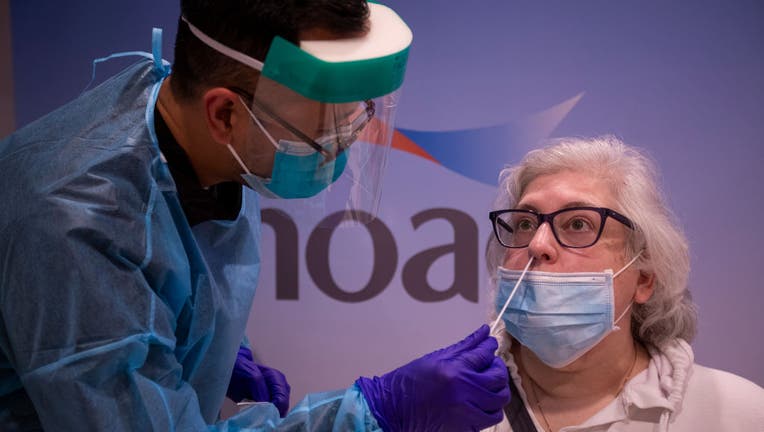CDC guidelines: When is the best time to get tested for COVID-19 after exposure?

Santa Ana, CA - December 21: Ergee Almalvez, left, licensed vocational nurse, Hoag Memorial Hospital Fly Well Clinic, administers a COVID-19 Rapid PCR test to Terri Black, of Aliso Viejo, for her and her husbands upcoming trip to London, England, at
WASHINGTON - COVID-19 cases are spiking nationwide concerning the omicron variant, and testing is one of the vital tools used to help slow the spread of the virus.
The Center for Disease Control and Prevention (CDC) has a list of guidelines explaining optimal times to get tested after exposure to someone with COVID.
According to the CDC, exposure is contact with someone infected with COVID-19 in a way that increases the likelihood of getting infected with the virus.
Exposure to COVID-19 can happen in three ways:
1) Inhaling respiratory droplets and aerosol particles.
2) Respiratory droplets and particles exposed on mucous membranes in the mouth, nose or eye by direct splashes and sprays.
3) Touching mucous membranes with hands that have been soiled either directly by "virus-containing respiratory fluids" or indirectly by touching surfaces with the virus on them.
Close contact with a person infected with COVID-19 is another way the virus is transmissible. According to the CDC, close contact refers to an individual less than six feet away from an individual infected with COVID for 15 minutes or more over 24 hours. An infected person can spread COVID beginning two days before they have symptoms.
Best times to get tested for COVID
People who have come into close contact with someone with COVID are urged to get tested at least five days after they last had close contact with the individual with the virus. The date of the last close contact is considered day zero.
The CDC recommends that fully vaccinated people get tested for the virus five to seven days after close contact with a person suspected or confirmed with having COVID-19.
According to the CDC, individuals who have tested positive for COVID-19 within the past three months and recovered do not have to get tested as long as they do not develop new symptoms.
Individuals who develop virus symptoms have to get tested immediately and must isolate until they receive their test results. The CDC says if you test positive, it’s important to follow isolation guidelines.
If an individual tests negative for COVID, the CDC says they’re allowed to leave home, but must wear a well-fitting mask when around others at home and in public until 10 days after last close contact with a person with COVID.
The CDC recommends people who test positive for the virus isolate for at least five days from the date of their positive test. If you develop COVID-19 symptoms, you must isolate for at least five days from the date your symptoms began.
Types of tests available to detect COVID
COVID tests can inform you if you have an infection at the time of testing, which is known as a viral test. These tests are used to search for viral infections. Viral tests involve the use of samples that come from your nose and mouth, according to the CDC.
Two commonly used viral tests are rapid tests and laboratory tests
The CDC says rapid tests are conducted in minutes and can include an antigen, a substance foreign to the body to draw out an immune response, and nucleic acid amplification tests (NAATs) which is a type of viral diagnostic test for COVID-19.
Laboratory tests commonly known as PCR tests can take several days to complete. Self-tests are quick COVID tests administered at home or anywhere a rapid test result can be recorded.
Tests for antibodies detect if you’ve had a past infection from COVID-19. The CDC states that your body creates antibodies after getting infected with COVID or if vaccinated. This is called an antibody test.
Antibody tests detect antibodies to COVID-19 in your blood. According to the CDC, antibodies are proteins that your immune system produces to help fight infection and protect you from getting sick.
This story was reported from Washington, D.C.

